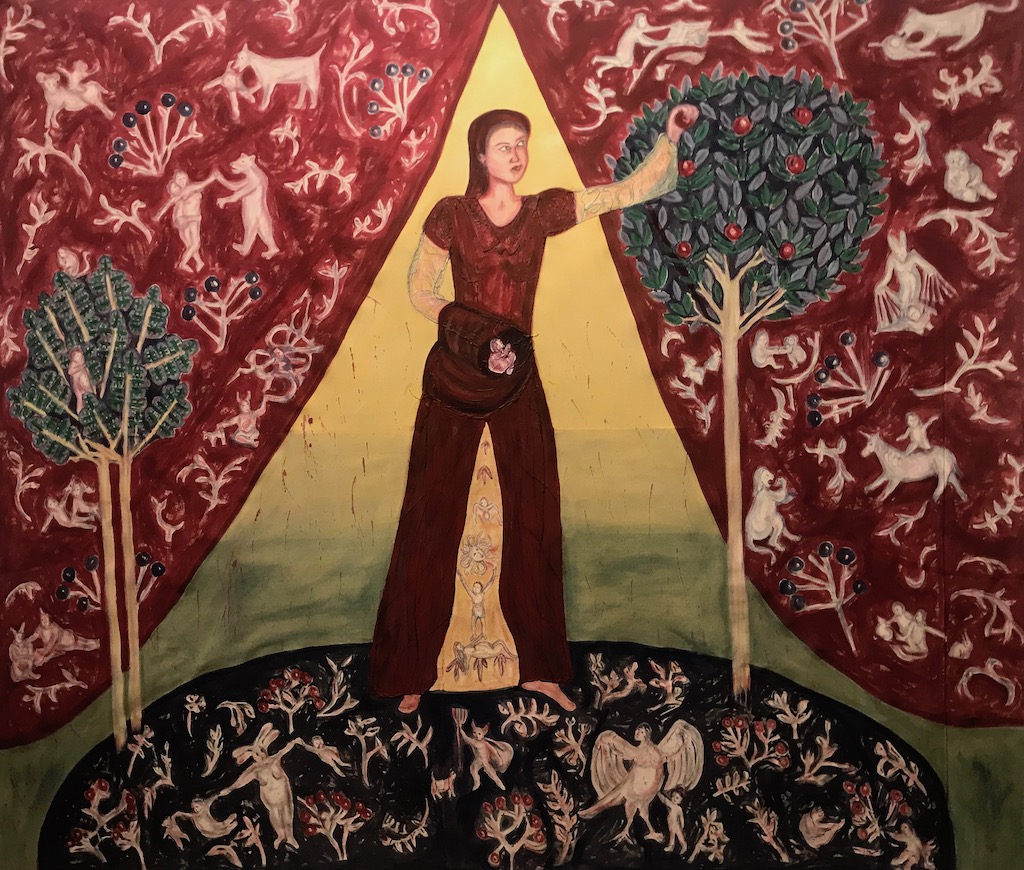
Writing about The sixth sense of understanding
Whilst I don’t often so directly reference other works of art (though like all painters appropriate constantly) I was drawn to the imagery, colours, and patterns in the most beautiful of all Tapestry Cycles La dame a Licorne a series of 15th century Flemish works in the style of mille-fleurs.
Interested in the symbolism of animals and plants and interpreting them, five of the tapestries are understood to depict the senses whilst in the one I reference – the sixth tapestry’s meaning is more obscure. It bears the words ‘a mon seul desir’ – ‘to my desire’, yet one of the interpretations I like best is that it is not about selfishness but represents the sixth sense – understanding. Since my paintings address care and empathy in order renegotiate status for such acts (often by women), re-appropriating some of the symbolism seems a perfect way to re-represent women’s lived experiences.
I had been painting curtains, using the canvas as woven cloth to reference women’s work and proposing affirmative change in domestic space. Figures invading household patterns, replacing the idea of merely looking (witness) with Ettinger’s empathetic notion of ‘with-ness’. We are all in the warp and weave of everyday life but asking questions about what we value.
Zooming in on central tent of the ‘a mon seul desir’ tapestry, the flaps of the tent in my painting become curtains. The central figure is a strange composite medieval-contemporary figure, who looks askance at the tree as she plucks a pomegranate. Pomegranates represent fertility, but also a pause in fertility—perhaps in myth and in life. She has a red dress with a panel featuring female figures in childbirth, Medusa and a baby roughly painted in her muff(!)
On the curtains and the floating sphere on which she stands, mythical and everyday creatures mix with pattern and become the pattern. It was a departure for me to include animals in painting. They became mythical creatures, metamorphosing half-women half beast composites. Aiming to humorously represent domestic lives of mothers and carers, I also wanted to create new transformative symbolism. I threw everything into the patterns – monsters, unicorns, rabbits, dancing bears, she-wolves, lions, bat women (Jorugama), a qualupalik (an Icelandic monster created to scare children away from the ice) stryx, babies riding goats, and children in unicorn T. shirts clutching cuddly toys.
The extreme eclectic mix becomes almost a carnivalesque experience, an alternate reality certainly, and an alternative space. Bakhtin’s notion that the carnival creates an alternative social space characterised by freedom, equality and abundance is a useful one. During medieval carnivals rank was abolished and everyone was equal. People were reborn into different human relations. Useful ideas for ways in which we might transform and metamorphose representations of domestic life, women and carers.
Figures, animals and hybrid creatures find their way through our subconscious and can confront contemporary concerns. Ancient myths, symbols and patterns speak to us in the present and and offer visions of complex yet changeable realities.
Delpha Hudson, December 2021
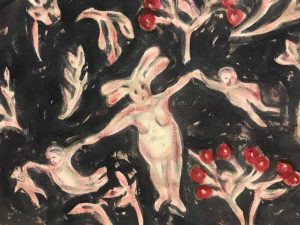
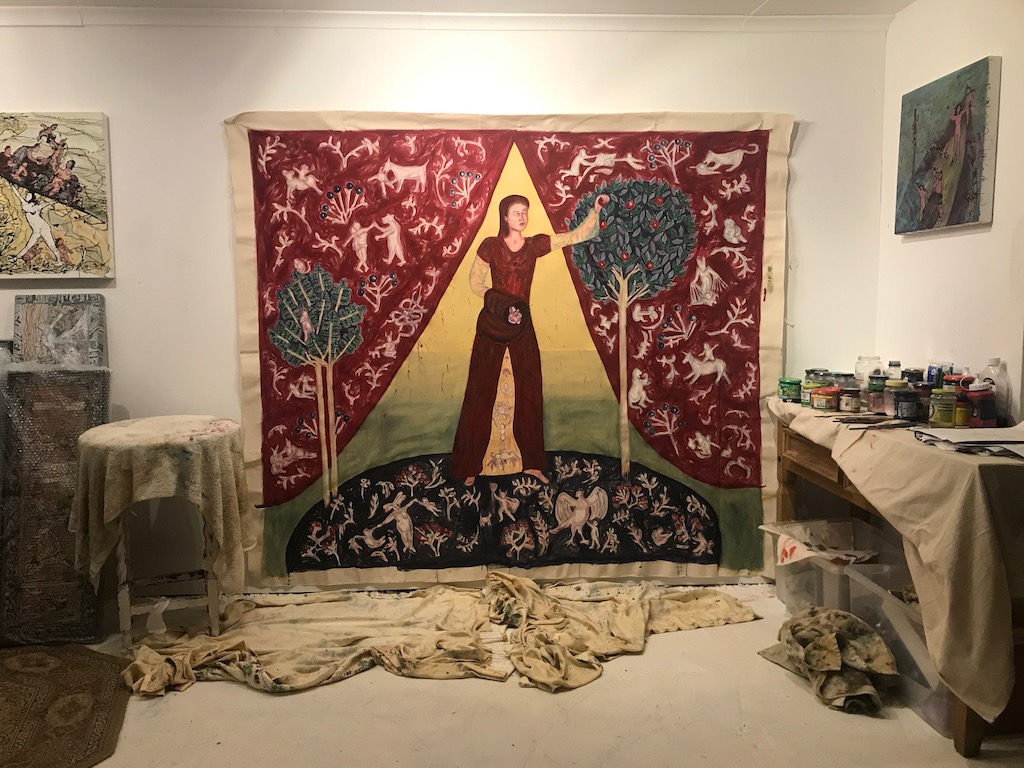
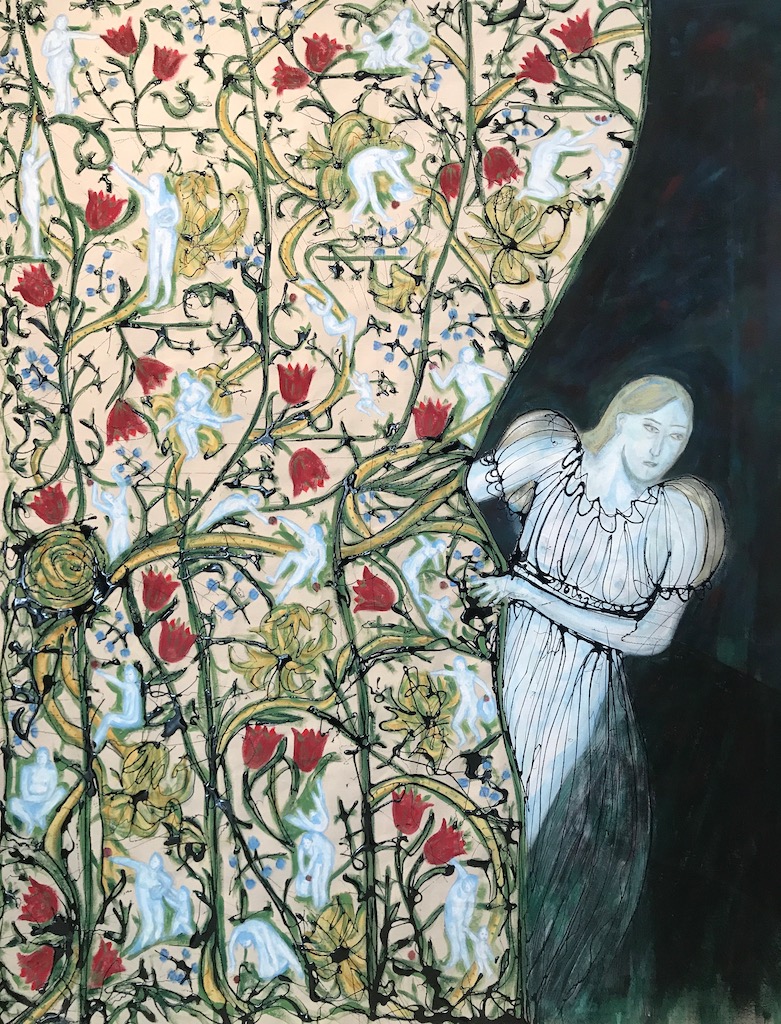
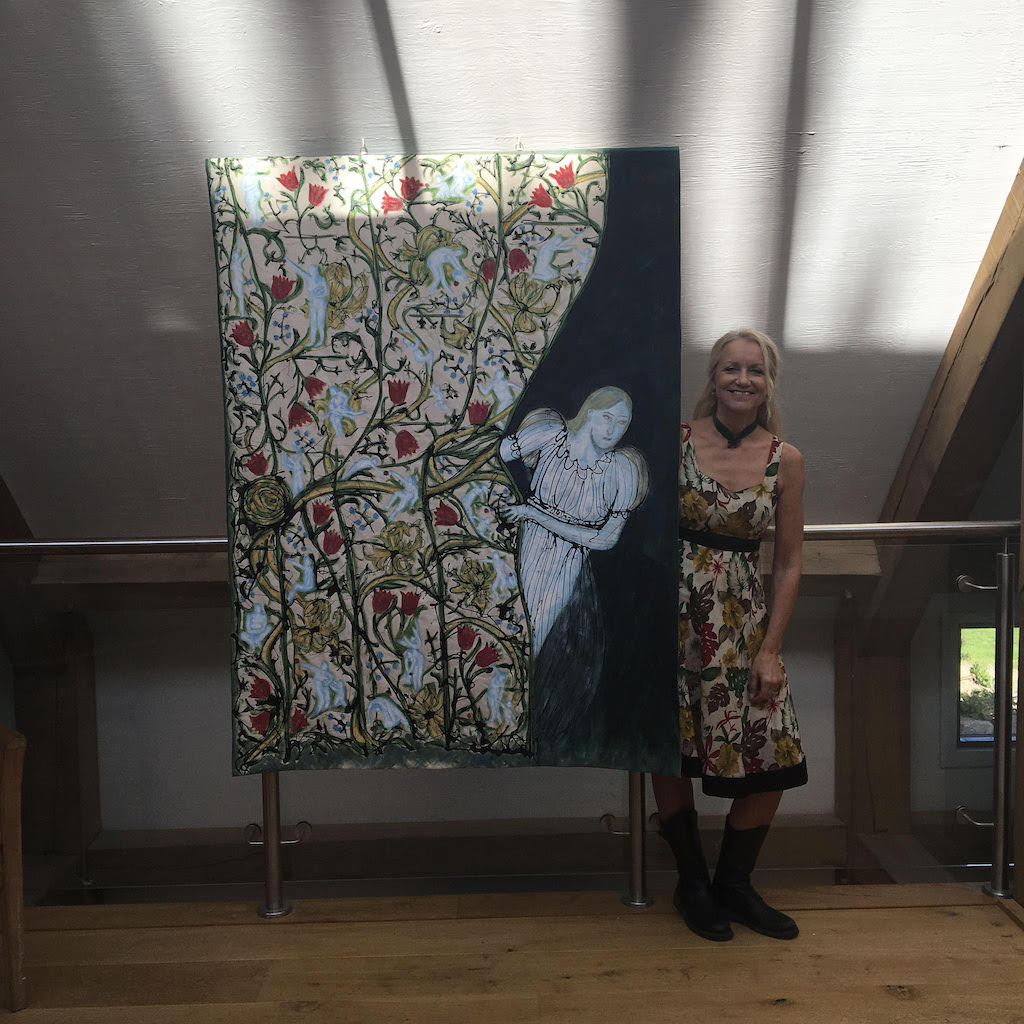
Writing about Consider the lilies of the field, how they grow; they toil not, neither do they spin.
I love ironic titles. The title is taken from a biblical quote that infers that we need not work or toil as all will be provided. This painting laughs at the implication as in patriarchal societies it is women who do all the work. It also riffs on a famous lily pattern design textile and classical Italian painting with the figure who pulls back the curtain. I love the idea of a process that creates multiple paintings within a painting.
The lily pattern is eaten away and partly destroyed in replication and an additional cast of characters hide in its domestic undergrowth. They are all care-givers and home-workers. The loosely dripped black bitumen paint provides dark treacly textures that obscure and destroy the pattern further. The cloth, the linen and the material (the subject and object) of painting create an interplay between our material senses and our experiences. Patterning becomes a language to be subtly invaded and changed, as dark symbol for adaptation.
Delpha Hudson, June 2021
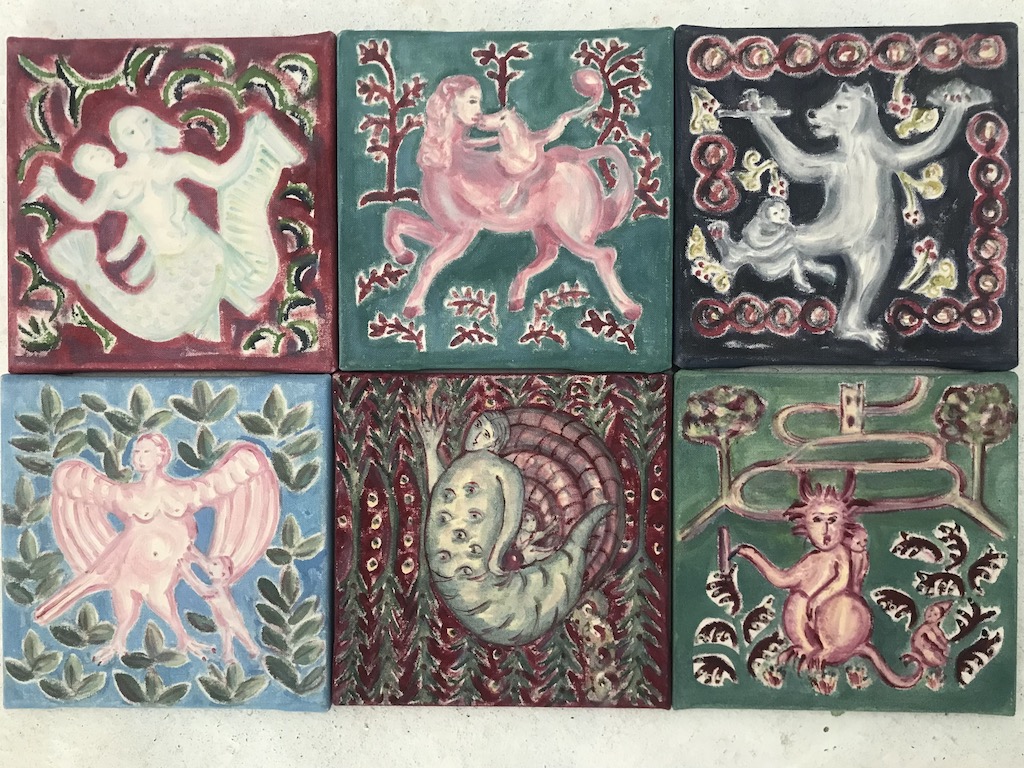
As a seasonal offer at the end of 2021, a series of small medievalesque acrylic canvases that satirically looked at caring and parenting were sold to support Wild Young Parents in Cornwall. Others were later shown at Salt projects in Truro. Some are still available. Do get in touch if you would like one.
Writing about Last and least wait till everything else has been eaten
Paintings create rich tapestries of dark yet colourful scenes that aim to re-shape our thinking about equality and visibility. Narrative is a central function of language and to learn to speak is to tell a story – yet that story has primarily been written or illustrated by men. Creating differentiated narratives that layer and connect time, people and equality, takes us on a journey and that ‘once upon a time’ tells us that things change. As we exist in the middle of our stories, we all need to be reminded that we can make the ending different.
The title is inspired by ‘The Double X Economy’ by Linda Scott.
Delpha Hudson, 2021
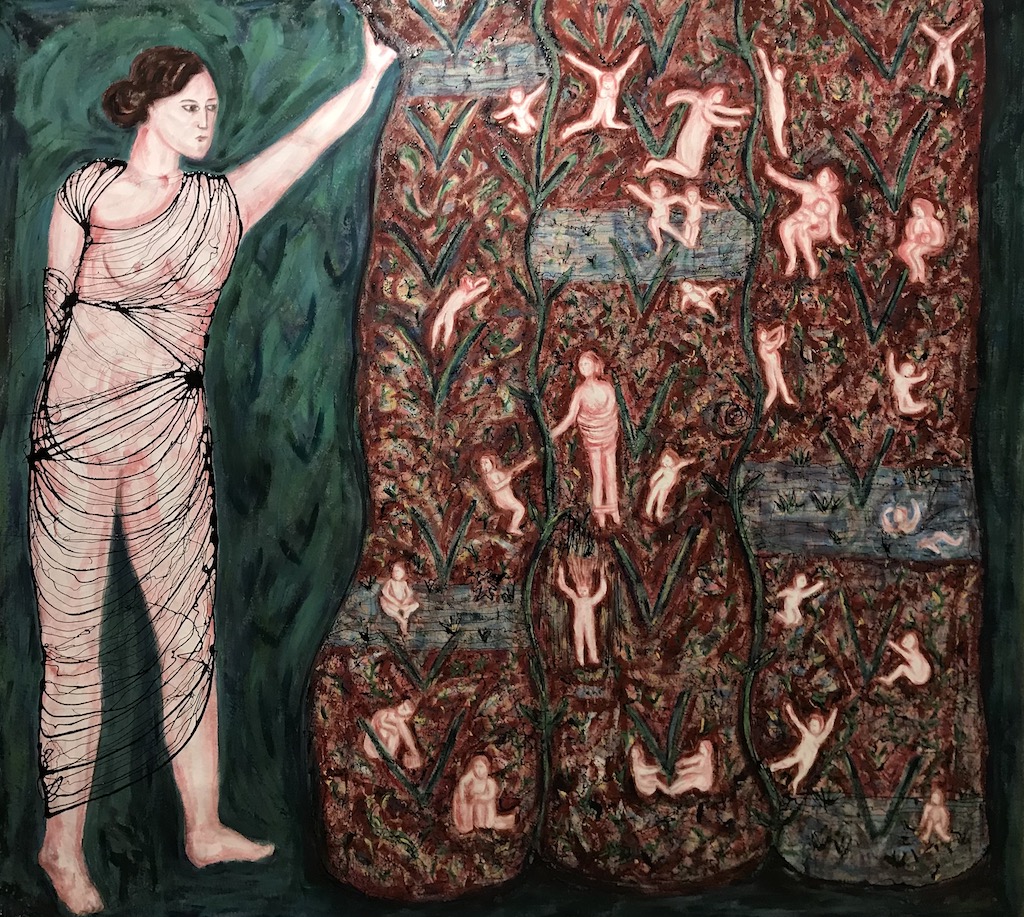
Writing about Despised and ashamed I tell you truly by them all I am condemned.
This was the first of a series of new large paintings on canvas that are not stretched out on frames but hung like tapestries. Many feature curtains as the main stage on which narratives play out. For mental health reasons, I have for many years often visualised cloth or curtains to cover ‘subjects’ of anxiety. They help me to prevent hamster wheels in my head. Like shutting a book on an unpleasant chapter, you know it may open up again but it gives temporary respite. The process has had limited success as things always leak through, yet it has helped to cloak some things until I could deal with them.
The title is a quote from Aechylus’ play ‘Clytemestra’, and aims to mock societal condemnation of women that aggravates their frequent feelings of guilt. Something that mothers and women so often experience. The painting’s medievalesque figure-stories explore women caught between societal judgement and an inherent guilt that tells them they must be a fault. Visually exploring past and present reveals devious cultural psychologies that trap women in cycles of guilt and anxiety and suggest that we share and laugh at our common condition in the hope that we can change society and ourselves.
Delpha Hudson, January 2021
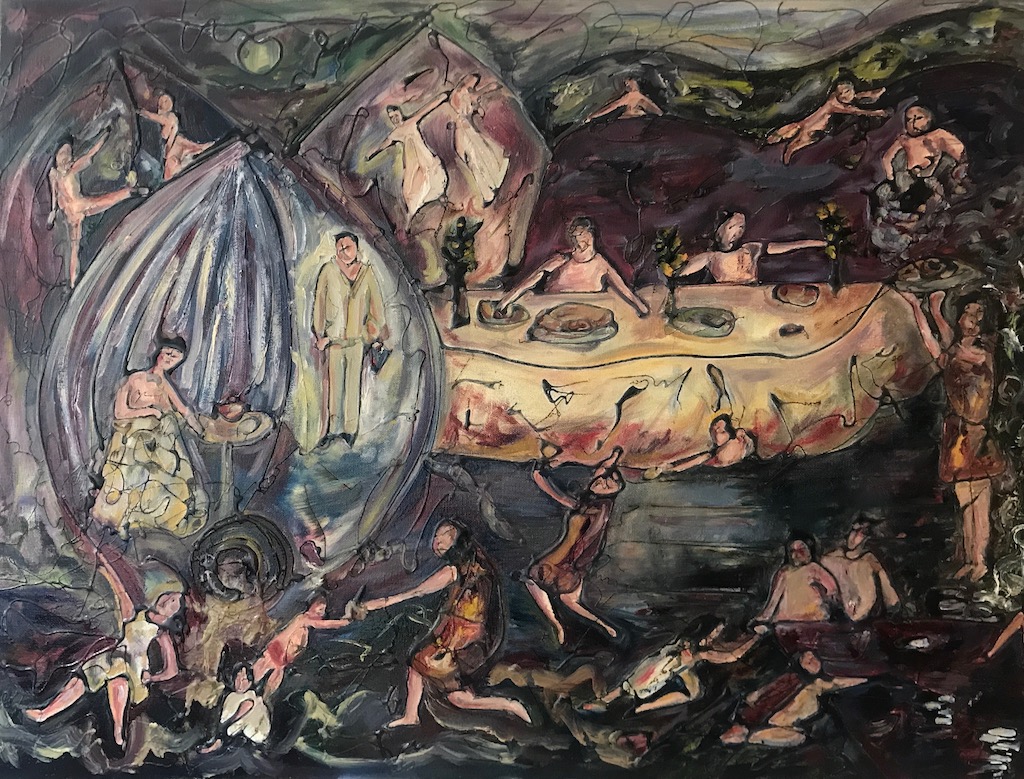
Writing about Last and least wait till everything else has been eaten
Paintings create rich tapestries of dark yet colourful scenes that aim to re-shape our thinking about equality and visibility. Narrative is a central function of language and to learn to speak is to tell a story – yet that story has primarily been written or illustrated by men. Creating differentiated narratives that layer and connect time, people and equality, takes us on a journey and that ‘once upon a time’ tells us that things change. As we exist in the middle of our stories, we all need to be reminded that we can make the ending different.
The title is inspired by ‘The Double X Economy’ by Linda Scott.
Delpha Hudson, 2021
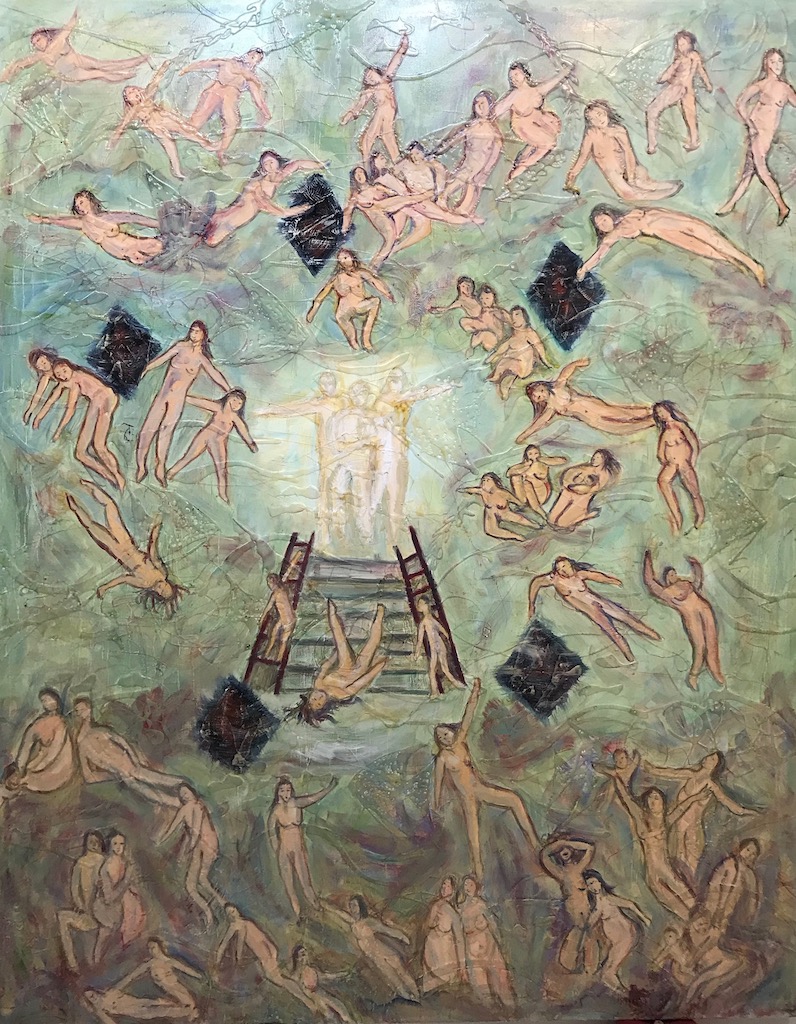
Writing about A history of domestic appliances
Exploring power relations and hierarchies, the title denies its historical and religious references, yet patriarchy is there in the central trinity of figures juxtaposed with a coat of arms of 5 ‘diapers’, the diamond patterns that led to the synonymous American ‘diapers’ because of the diamond pattern cloth. We call them nappies in the UK.
Bizarre domestic settings situate women and mothers in new imaginary realms that challenge domestic legacies of inequality, guilt and misrepresentation that damage women’s mental health. Dripping and layering canvases creates dynamic networks from which figures weave narratives that aim to humorously engage our empathy and propose that we initiate new conversations about who and what we value.
Delpha Hudson, 2021
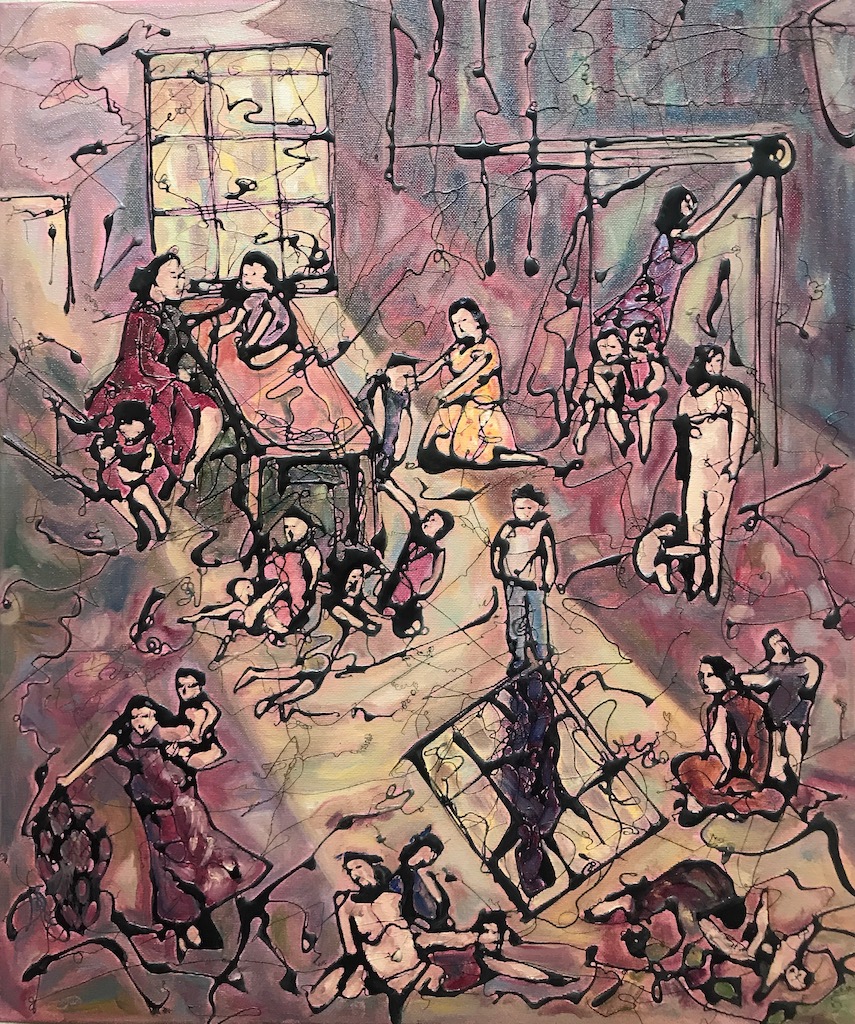
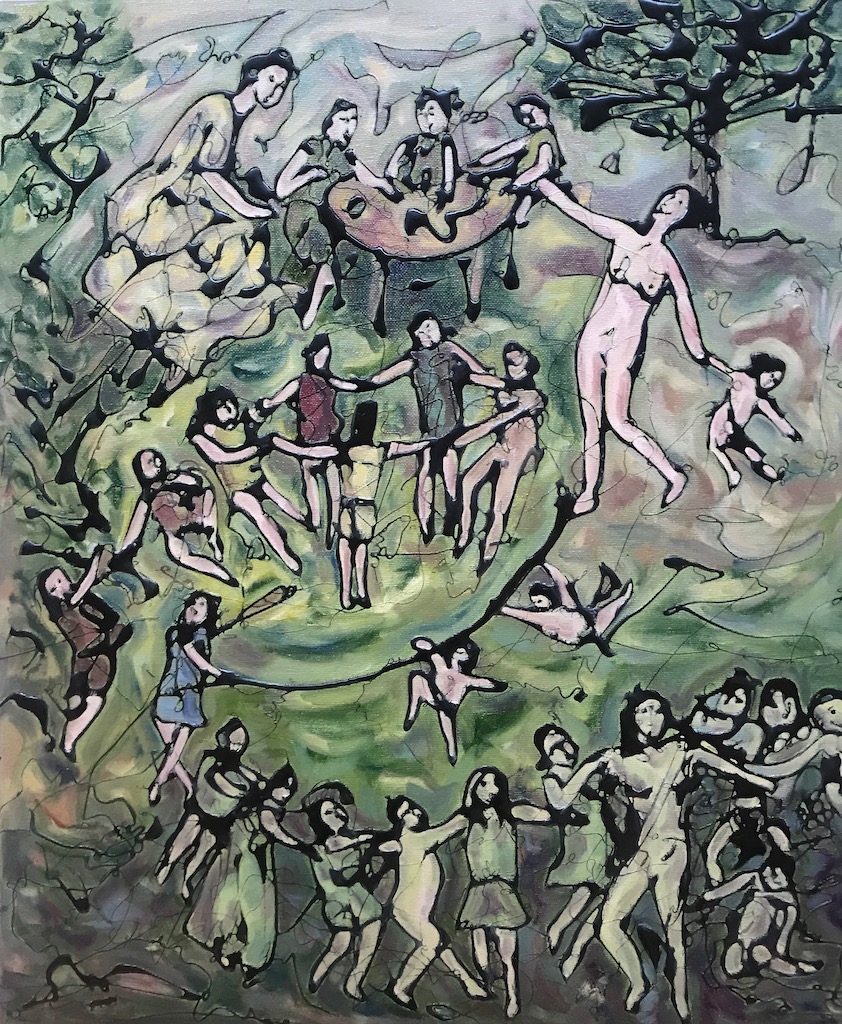
Paintings made to celebrate women artists especially for Newlyn Society of Artists 125 year anniversary.
These two paintings were made in response to work by Elizabeth Stanhope Forbes in order to explore and celebrate her work as an exceptional woman artist:
Elizabeth Forbes was an exceptional painter and one of the founders of the Newlyn Society of Artists. Unusual for the time, she juggled being a wife with a professional life, setting up the Passmore Edwards building (now Newlyn Art Gallery) and having a professional painting practice despite being side-lined by her more famous husband Stanhope-Forbes.
I was drawn to Elizabeth Forbes’ intimate domestic representations of mothers and children as my own work deals with representing the (often invisible) lived experience of women and motherhood. It is interesting how we might now interpret her nostalgic and intimate paintings of care and childhood. I love the way she exalts humdrum activities. On the knife-edge of tropes of idolised motherhood I aim for a darker edge, filling my canvases with her figures, riffing on them with dripped bitumen paint, and letting new figures crowd onto the canvas through the process.
There is something idyllic and fairytale in capturing moments of idealised childhood and home life – and this is reflected in my use of colour. Yet such moments are fleeting, and often in-between the hellish activities of balancing work, mothering and caring.
My paintings pay homage to Elizabeth Forbes whilst working against ideality through a gin alley chaos that satisfies my enquiry into darker representations of domesticity, asking questions about our common experience of childcare, mental health and societal value.
Delpha Hudson, 2021
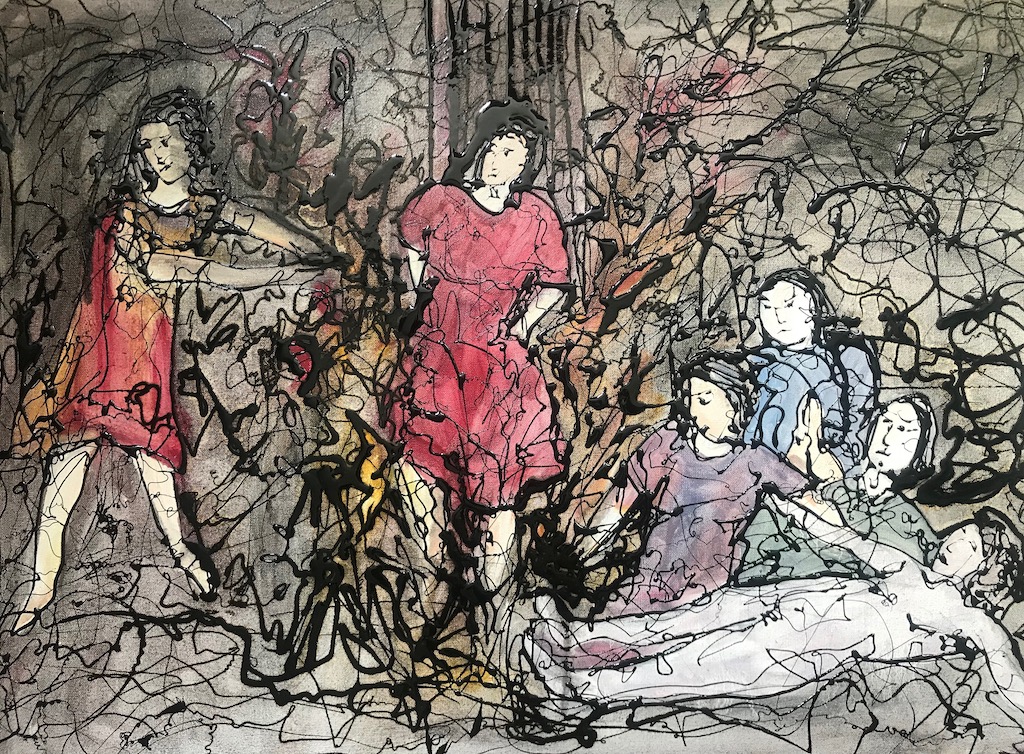
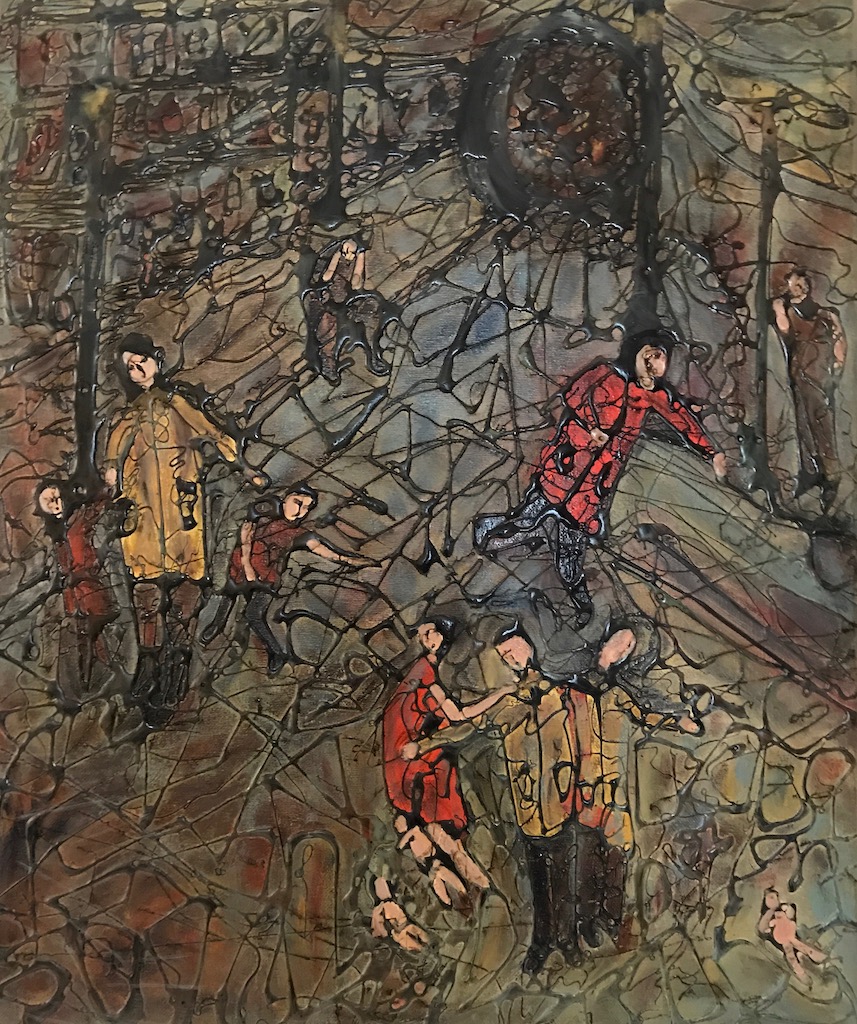
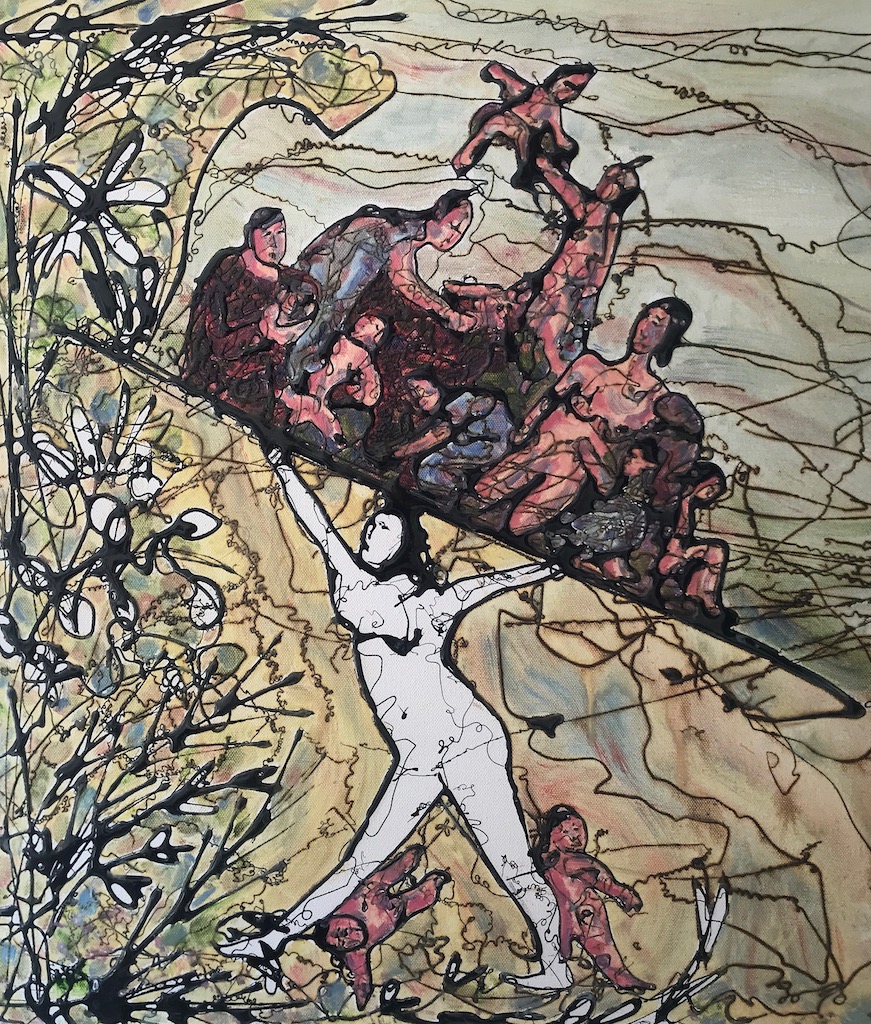
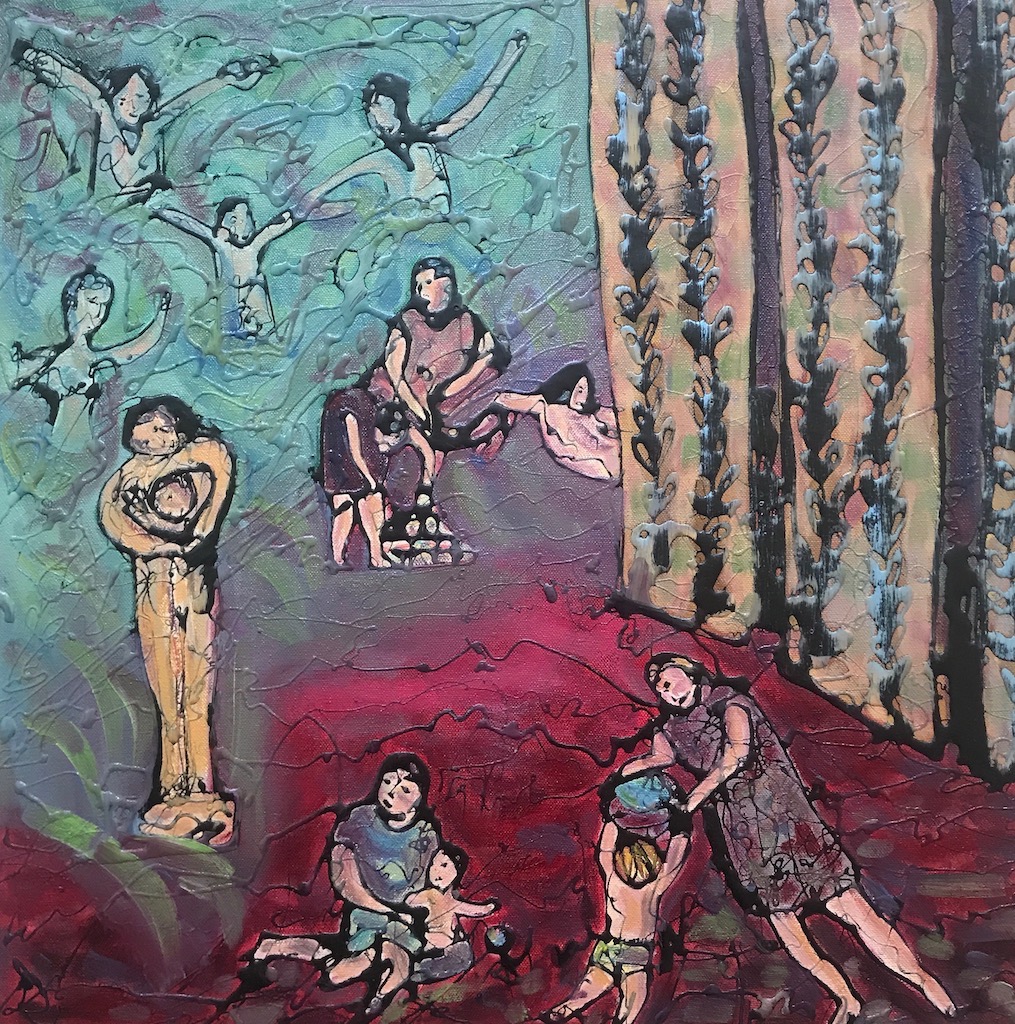
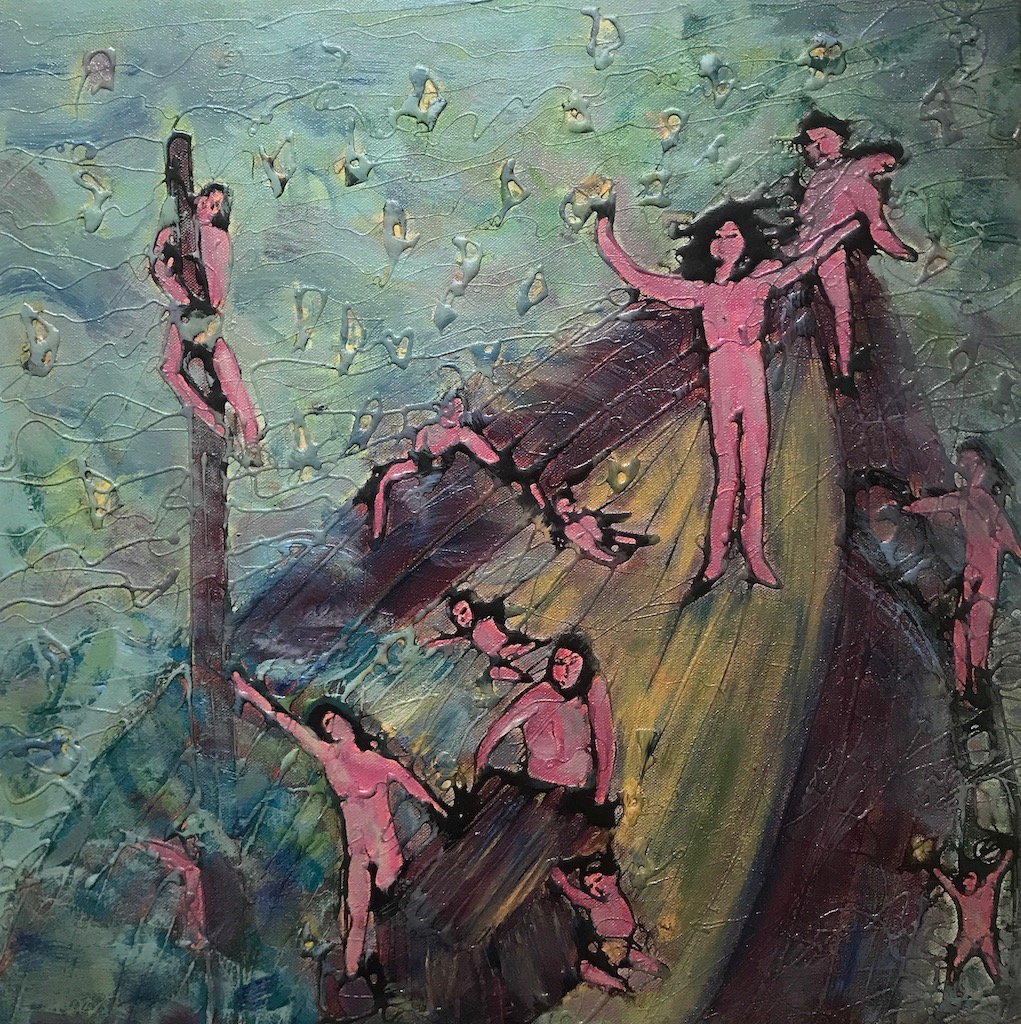
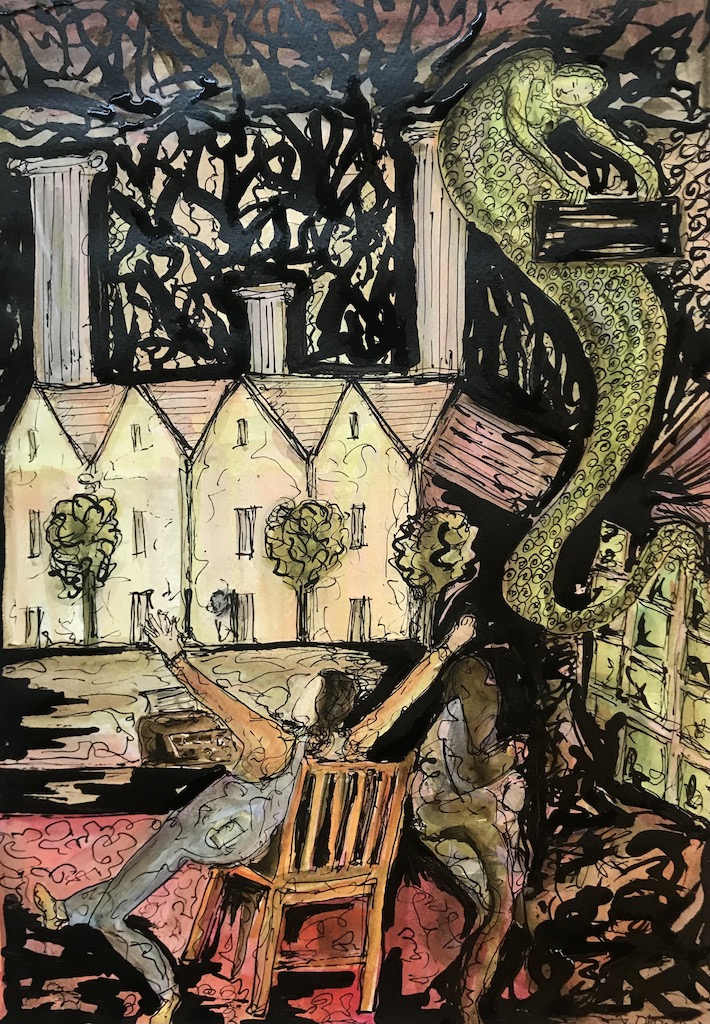
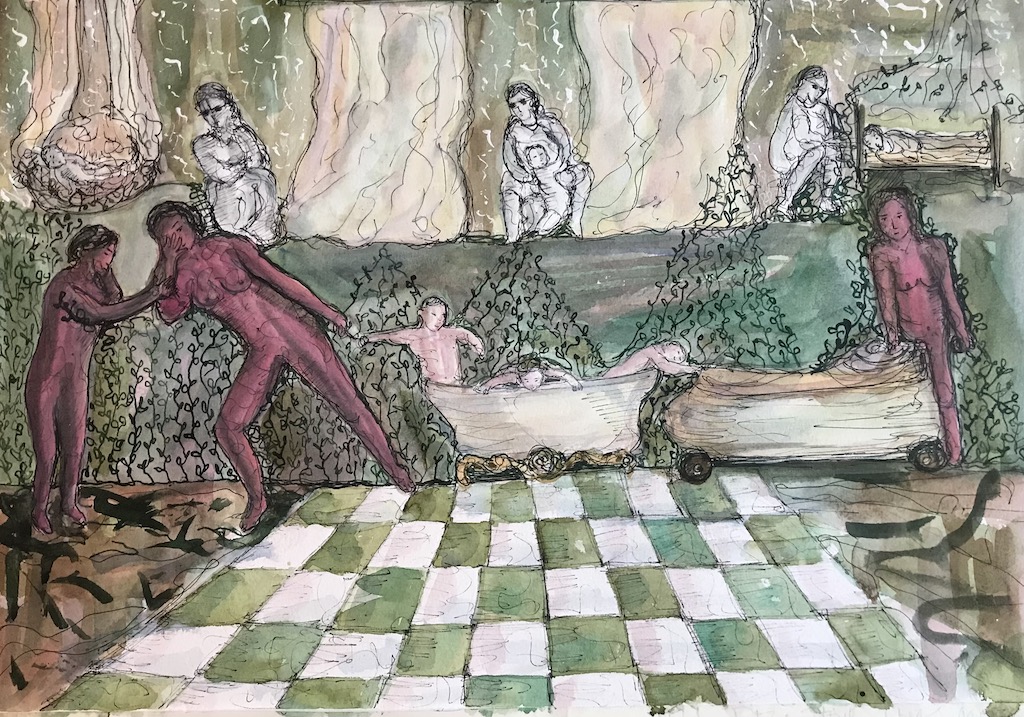
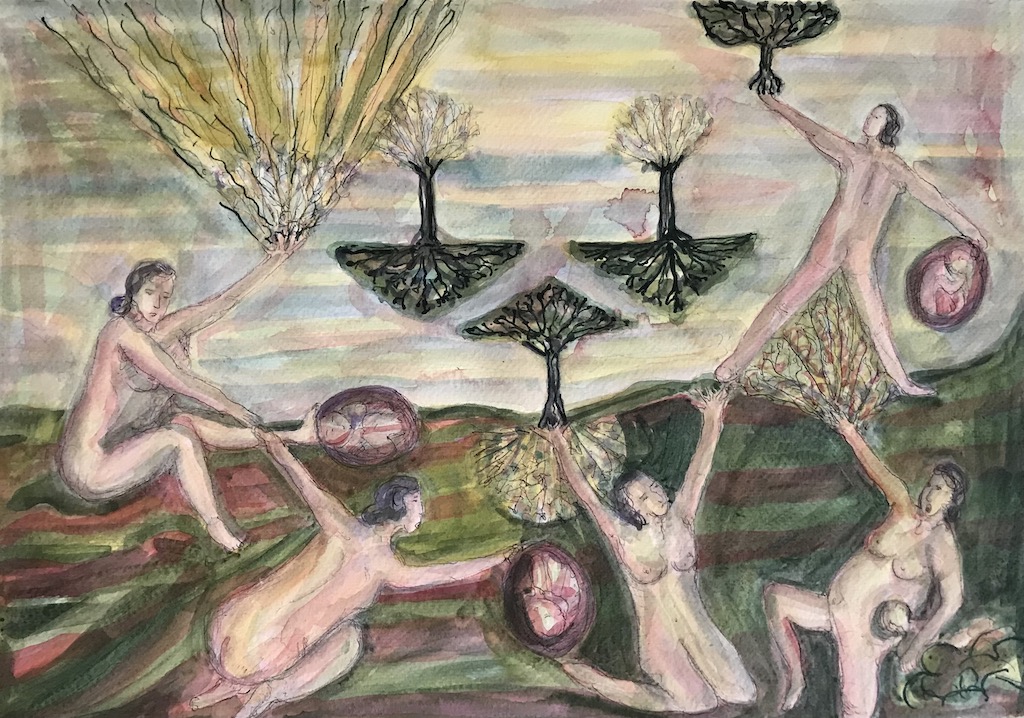
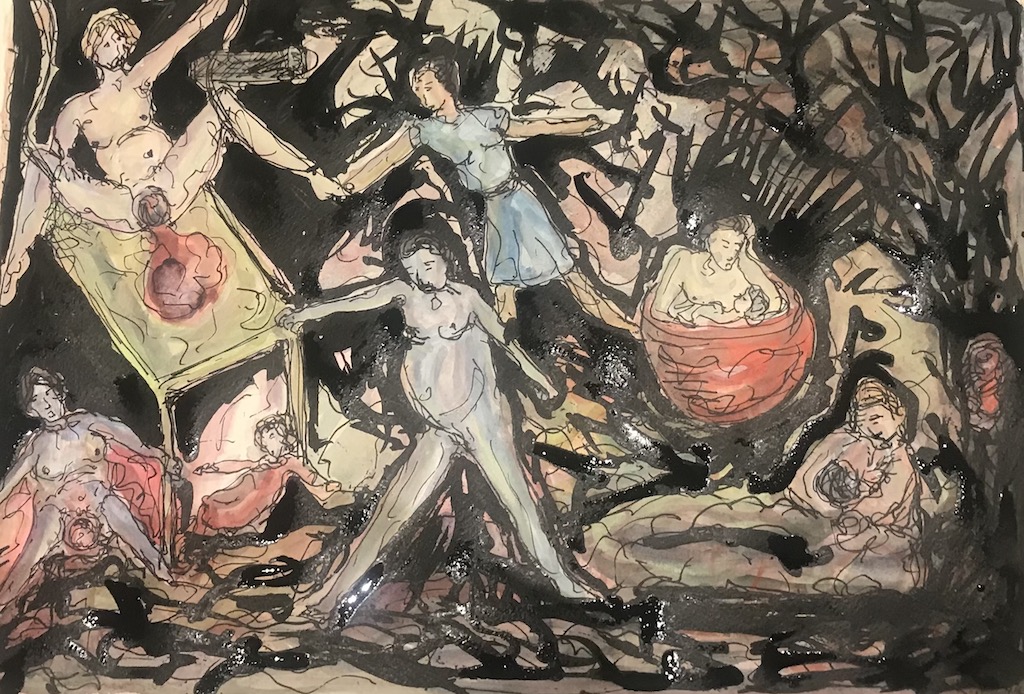
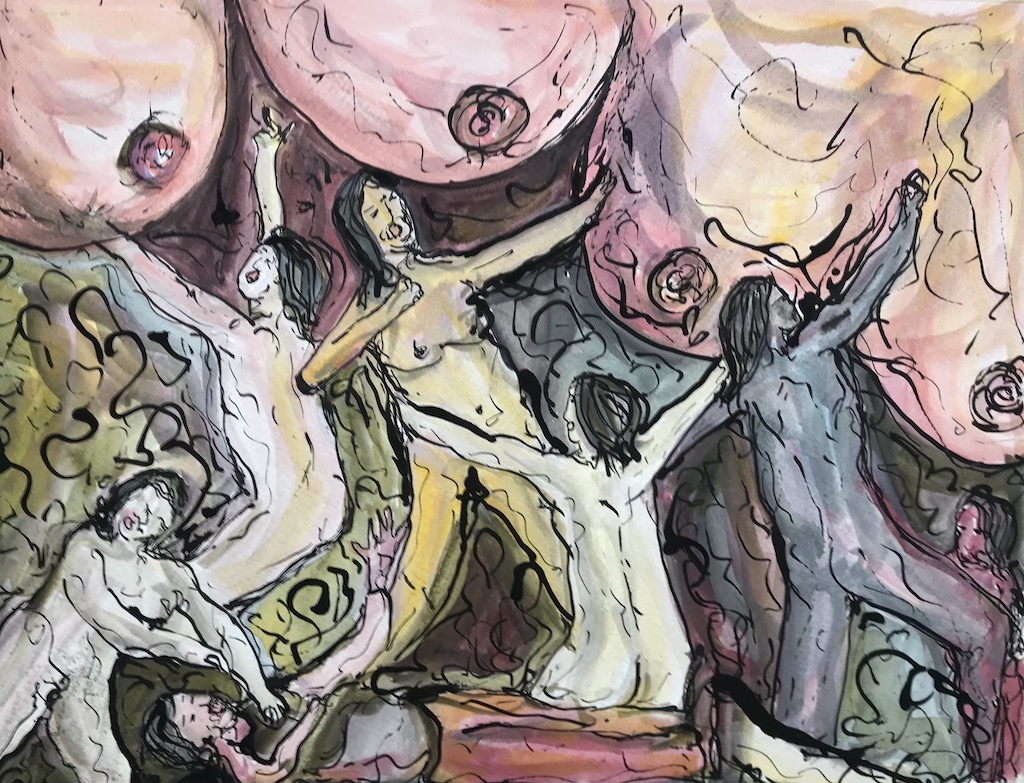

on paper, 30x42cm, 2021
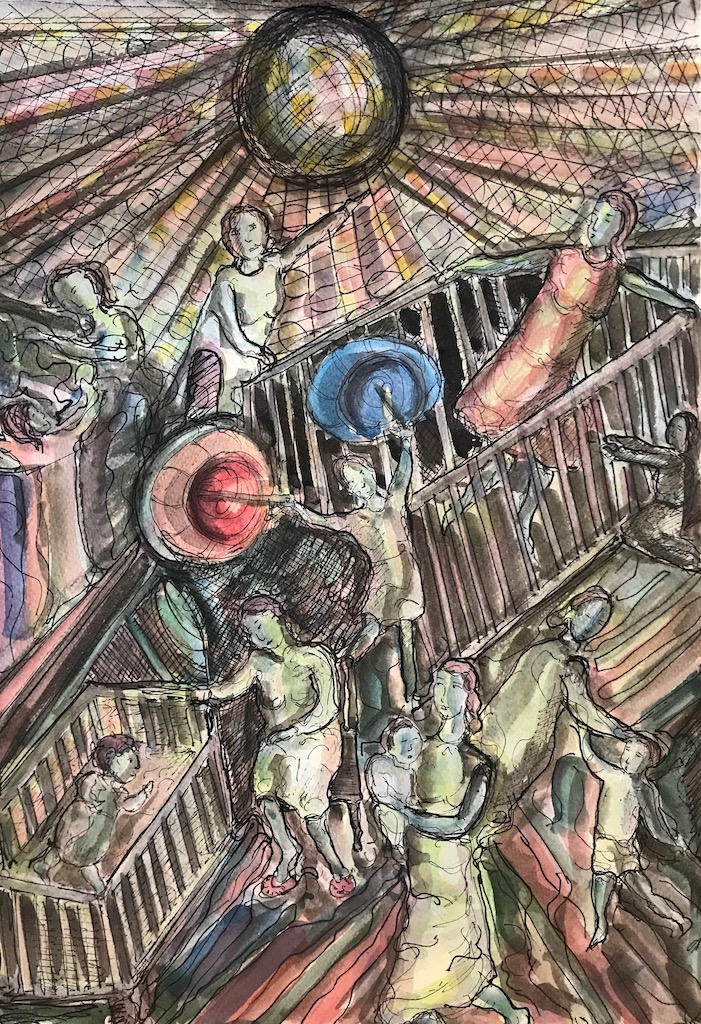
Paintings & works on paper are available for sale or get in touch.